| Listing 1 - 10 of 35 | << page >> |
Sort by
|
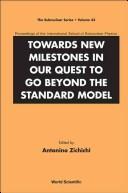
ISBN: 1281937940 9786611937942 9812779124 9789812779120 9789812779113 9812779116 Year: 2007 Volume: v. 43 Publisher: Singapore Hackensack, NJ World Scientific
Abstract | Keywords | Export | Availability | Bookmark
 Loading...
Loading...Choose an application
- Reference Manager
- EndNote
- RefWorks (Direct export to RefWorks)
This volume is a collection of lectures given by distinguished physicists from around the world, covering the most recent advances in theoretical physics and the latest results from current experimental facilities. Following one of the principal aims of the School - to encourage and promote young physicists to achieve recognition at an international level - the students who distinguished themselves for the excellence of their research were given the opportunity to publish their presentations in this volume. Sample Chapter(s)
Chapter 1: Experimental Signatures of Strings and Branes
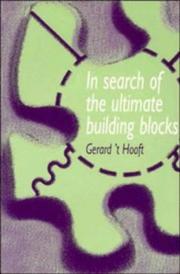
ISBN: 1139882201 1107264332 1107263751 1107266815 1107263255 110726989X 1107340853 9781107266810 9781107340855 9781107263253 0521550831 9780521550833 0521578833 9780521578837 Year: 1997 Publisher: Cambridge New York, NY, USA Cambridge University Press
Abstract | Keywords | Export | Availability | Bookmark
 Loading...
Loading...Choose an application
- Reference Manager
- EndNote
- RefWorks (Direct export to RefWorks)
This is a first-hand account of one of the most creative and exciting periods of discovery in the history of physics. From 1960 until 1990 theoreticians and experimentalists worked together to probe deeper and deeper into the basic structure of reality, moving closer and closer to an understanding of the ultimate building blocks from which everything in the Universe is made. Gerard 't Hooft was closely involved in many of the advances in the development of the subject. In this book he gives a personal account of the process by which physicists came to understand the structure of matter, and to speculate on possible directions in which the subject may evolve in the future. This fascinating personal account of the last thirty years in one of the most dramatic areas in twentieth century physics will be of interest to professional physicists and physics students, as well as the educated general reader with an interest in one of the most exciting scientific detective stories ever.
Standard model (Nuclear physics) --- Nuclear models --- Nuclear reactions
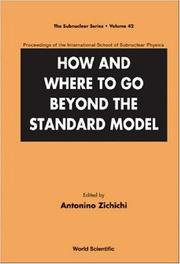
ISBN: 1281120863 9786611120863 9812708421 9789812708427 9789812567505 981256750X Year: 2007 Volume: v.42 Publisher: Singapore Hackensack, NJ World Scientific
Abstract | Keywords | Export | Availability | Bookmark
 Loading...
Loading...Choose an application
- Reference Manager
- EndNote
- RefWorks (Direct export to RefWorks)
This volume is a collection of lectures given during the 42nd Course of the International School of Subnuclear Physics. The contributions cover the most recent advances in theoretical physics and the latest results from current experimental facilities. In line with one of the aims of the school, which is to encourage and promote young physicists to achieve recognition at an international level, the students' recognized for their research excellence were given the opportunity to publish their work in this volume. Their contributions are joined by those from many distinguished lecturers in the f
Standard model (Nuclear physics) --- Supersymmetry --- Particles (Nuclear physics)
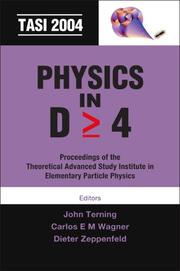
ISBN: 9812773576 9789812773579 9789812568090 9812568093 Year: 2006 Publisher: Hackensack, NJ : World Scientific,
Abstract | Keywords | Export | Availability | Bookmark
 Loading...
Loading...Choose an application
- Reference Manager
- EndNote
- RefWorks (Direct export to RefWorks)
This book contains write-ups of lectures from a summer school for advanced graduate students in elementary particle physics. In the first lecture, Scott Willenbrock gives an overview of the standard model of particle physics. This is followed by reviews of specific areas of standard model physics : precision electroweak analysis by James Wells, quantum chromodynamics and jets by George Sterman, and heavy quark effective field by Matthias Neubert. Developments in neutrino physics are discussed by Andre de Gouvea and the theory behind the Higgs boson is addressed by Laura Reina. Collider phenomenology from both experimental and theoretical perspectives are highlighted by Heidi Schellman and Tao Han. A brief survey of dynamical electroweak symmetry breaking is provided by R Sekhar Chivukula and Elizabeth H Simmons. Martin Schmaltz covers the recent proposals for "little" Higgs theories. Markus Luty describes what is needed to make supersymmetric theories realistic by breaking supersymmetry. There is an entire series of lectures by Raman Sundrum, Graham Kribs, and Csaba Csaki on extra dimensions. Finally, Keith Olive completes the book with a review of astrophysics.
Book
ISBN: 1009291009 1009291033 Year: 2022 Publisher: Cambridge : Cambridge University Press,
Abstract | Keywords | Export | Availability | Bookmark
 Loading...
Loading...Choose an application
- Reference Manager
- EndNote
- RefWorks (Direct export to RefWorks)
Describing the fundamental theory of particle physics and its applications, this book provides a detailed account of the Standard Model, focusing on techniques that can produce information about real observed phenomena. It begins with a pedagogic account of the Standard Model, introducing essential techniques such as effective field theory and path integral methods. It then focuses on the use of the Standard Model in the calculation of physical properties of particles. Rigorous methods are emphasized, but other useful models are also described. The second edition has been updated to include theoretical and experimental advances, such as the discovery of the Higgs boson, our understanding of neutrinos, and the major advances in CP violation and electroweak physics. This book is valuable to graduate students and researchers in particle physics, nuclear physics and related fields. This edition, first published in 2014, has been reissued as an Open Access publication on Cambridge Core.
Standard model (Nuclear physics) --- Nuclear models --- Nuclear reactions --- Electroweak interactions.
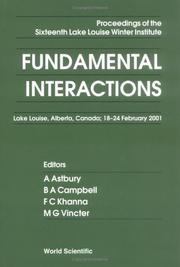
ISBN: 9812777709 9789812777706 9789810249120 9810249128 9810249128 Year: 2002 Publisher: River Edge, N.J. World Scientific
Abstract | Keywords | Export | Availability | Bookmark
 Loading...
Loading...Choose an application
- Reference Manager
- EndNote
- RefWorks (Direct export to RefWorks)
The Lake Louise Winter Institute is held annually to explore recent trends in physics. The proceedings contain pedagogical and review lectures by invited experts and contributed presentations by participants.
Contents:
- Physics at TESLA (G A Blair)
- Searches at HERA (N Delerue)
- Particle Production and Multiplicity in Heavy Ion Collisions at PHENIX (L Ewell)
- Two Photon Physics at LEP (D Haas)
- Higgs Searches with the DELPHI Detector (J Hansen)
- Noncummutative Field Theories and Spontaneous Symmetry Breaki
Particles (Nuclear physics) --- Standard model (Nuclear physics) --- Measurement
Book
ISBN: 1282761285 9786612761287 9814280941 9789814280945 9781282761285 6612761288 9814280933 9789814280938 Year: 2009 Publisher: Singapore Hackensack, N.J. World Scientific Pub. Co.
Abstract | Keywords | Export | Availability | Bookmark
 Loading...
Loading...Choose an application
- Reference Manager
- EndNote
- RefWorks (Direct export to RefWorks)
This book contains pedagogical lectures on both theoretical and experimental particle physics, cosmology, and atomic trap physics. Numerous additional contributions provide up-to-date information on new experimental results from accelerators, underground laboratories, and nuclear astrophysics. This combination of pedagogical talks and topical short discussions presents a comprehensive amount of information and latest developments to researchers.
Nuclear reactions --- Particles (Nuclear physics) --- Standard model (Nuclear physics) --- Astrophysics --- Nuclear astrophysics --- Measurement
Book
ISBN: 0300252463 9780300252460 9780300244182 0300244185 Year: 2020 Publisher: New Haven
Abstract | Keywords | Export | Availability | Bookmark
 Loading...
Loading...Choose an application
- Reference Manager
- EndNote
- RefWorks (Direct export to RefWorks)
The history of particle physics, the hunt for the most elusive particle, and the fundamental questions the search has inspired How did physicists combine talent and technology to discover the Higgs boson, the last piece in our inventory of the subatomic world? How did the Higgs change our understanding of the universe? And now, nearly a decade after its detection, what comes next? Answering these questions, Ivo van Vulpen-a CERN particle physicist and member of the team behind the detection-invites us on a journey to the frontiers of our knowledge. Enjoy van Vulpen's accessible explanation of the history of particle physics and of concepts like quantum mechanics and relativity-and ponder his inquiries regarding the search for new particles (to explain dark matter), a new force (to combine the existing fundamental forces), and new phenomena (undiscovered dimensions of space). This is a lively account of work at the world's highest-energy particle accelerator, with inspiring personal reflections on humanity's discoveries deeper and deeper into the world of the very small.
Particles (Nuclear physics) --- Standard model (Nuclear physics) --- Higgs bosons. --- Z bosons. --- Quantum theory.
Book
ISBN: 1282443011 9786612443015 9814261211 9789814261210 9781282443013 9789814261203 9814261203 6612443014 Year: 2009 Publisher: Singapore Hackensack, NJ World Scientific
Abstract | Keywords | Export | Availability | Bookmark
 Loading...
Loading...Choose an application
- Reference Manager
- EndNote
- RefWorks (Direct export to RefWorks)
Space-based laboratory research in fundamental physics is an emerging research discipline that offers great discovery potential and at the same time could drive the development of technological advances which are likely to be important to scientists and technologists in many other different research fields. The articles in this review volume have been contributed by participants of the international workshop "From Quantum to Cosmos: Fundamental Physics Research in Space" held at the Airlie Center in Warrenton, Virginia, USA, on May 21-24, 2006. This unique volume discusses the advances in our
Astrophysics --- Quantum gravity --- Dark energy (Astronomy) --- Standard model (Nuclear physics) --- General relativity (Physics) --- Cosmology
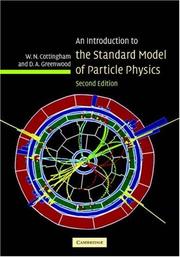
ISBN: 9780521852494 0521852498 9780511791406 9780511568244 0511273770 9780511273773 0511271360 9780511271366 0511649061 9780511649066 0511791402 0511272987 9780511272981 1281836397 9781281836397 1107165415 9786611836399 0511438869 1139814117 051156824X Year: 2008 Publisher: Cambridge Cambridge University Press
Abstract | Keywords | Export | Availability | Bookmark
 Loading...
Loading...Choose an application
- Reference Manager
- EndNote
- RefWorks (Direct export to RefWorks)
The second edition of this introductory graduate textbook provides a concise but accessible introduction to the Standard Model. It has been updated to account for the successes of the theory of strong interactions, and the observations on matter-antimatter asymmetry. It has become clear that neutrinos are not mass-less, and this book gives a coherent presentation of the phenomena and the theory that describes them. It includes an account of progress in the theory of strong interactions and of advances in neutrino physics. The book clearly develops the theoretical concepts from the electromagnetic and weak interactions of leptons and quarks to the strong interactions of quarks. Each chapter ends with problems, and hints to selected problems are provided at the end of the book. The mathematical treatments are suitable for graduates in physics, and more sophisticated mathematical ideas are developed in the text and appendices.
Elementary particles --- Standard model (Nuclear physics) --- Standard model (Nuclear physics). --- Particles (Nuclear physics). --- Particules (Physique nucléaire) --- Particles (Nuclear physics) --- Elementary particles (Physics) --- High energy physics --- Nuclear particles --- Nucleons --- Nuclear physics --- Nuclear models --- Nuclear reactions
| Listing 1 - 10 of 35 | << page >> |
Sort by
|

 Search
Search Feedback
Feedback About UniCat
About UniCat  Help
Help News
News